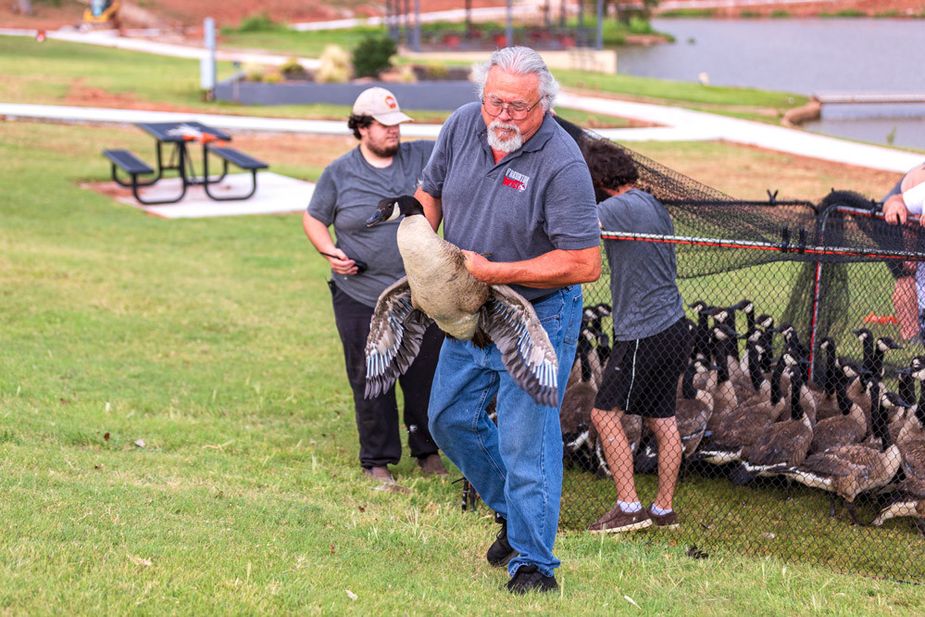Wing Commanders
Published April 2025
By Joseph Hoyt | 5 min read
Lakeside parks, lawns, and golf courses are popular destinations on warm Oklahoma afternoons. These are also choice locations for Canada geese. In fact, Canada geese, once on the verge of extinction, are thriving in Oklahoma, so much that in many areas, they are becoming a nuisance. When a public area has become overpopulated with these large waterfowl, a goose roundup may be the best solution.
Mark and Ann Runnels created their Bartlesville-based company, Predator Impact, to humanely manage geese and other wildlife when they become trouble. Each year in June and July, Mark, sometimes Ann, and a group of volunteers, both paid and unpaid, corral flocks of geese. Using kayaks, portable corrals, and specialized trailers, they round up the waterfowl like cattle and relocate them to another lake at least a hundred miles away from the area they have overpopulated. Their new home also must be approved by the Oklahoma Department of Wildlife Conservation.

Normally, Predator Impact gathers around 200 geese per outing, but in 2021, they picked up a record 360 from a golf course in Broken Arrow. Photo by John Burns
These few weeks in June and July present the perfect window of opportunity to corral the geese, because this is their molting period. Most birds molt once a year, meaning they drop their feathers and regrow new ones. Often they lose only a few pinion feathers—the outermost flight feathers on the tips of their wings—at a time, so they can fly while molting. Geese, on the other hand, drop all their flight feathers at once. For a few weeks, they can run, walk, and swim, but they cannot fly. Also, this early in the year, goslings cannot fly yet.
The crew takes care that no geese are harmed or killed during the relocation process. In fact, the goslings are separated from the adults and placed in special carriers so they are not injured or trampled during transport. Then they are reunited with the adults at the new location.
“The relocated geese spend the rest of the summer regrowing their flight feathers and becoming acclimated to their new area. They do not return to the area they were removed from,” Mark says. “New geese may eventually find their way to property where geese were removed, but those we removed will not return. The state has done banding studies, and there has never been a case where a banded goose that was relocated came back to where it was caught.”
Last year, Predator Impact relocated 997 geese in the state. Among those birds, there are two varieties of Canada geese in Oklahoma—those that migrate and those that stay here all year long. It’s the birds that remain in the state that are the problem. An adult Canada goose can eat up to four pounds of grass per day and excrete up to three pounds of fecal matter. They will strip a yard and leave walking areas and docks covered with poop and feathers. Also, Canada geese can become aggressive.
“For some reason, they are attracted to people walking along sidewalks with canes, so older people are especially vulnerable,” Mark says. “Recently, they attacked a ninety-two-year-old woman.”
In 2021, Mark evacuated 360 geese from a nine-hole golf course in Broken Arrow.
“Golfers were accidentally hitting geese with golf balls,” he says. “Some greens were stripped bare, and it was like walking in a sea of goose poop.”
Predator Impact relies on assistance—paid and volunteer—from people across the state, especially those with kayaks. It might not be glamorous work, but what’s good for the goose is good for their fellow Okies.
PREDATOR IMPACT
- (918) 397-4091
- predatorimpact.com







